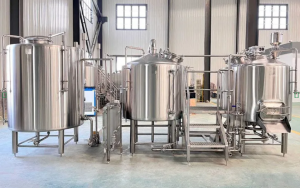
Brewing beer is an ancient craft that has evolved significantly over the centuries. Today, it’s not just about large-scale commercial operations but also about the growing culture of homebrewing. While both home brewing and commercial brewing share the same fundamental principles, there are key differences that set them apart. In this article, we’ll delve into the nuances of each, exploring their distinct characteristics and the unique experiences they offer.
Scale and Production Capacity:
Perhaps the most obvious difference between home brewing and commercial brewing is the scale of production. Commercial breweries operate on a large scale, producing thousands to millions of gallons of beer annually. They have industrial-grade equipment, massive fermentation tanks, and sophisticated packaging lines to meet consumer demand. In contrast, homebrewers typically brew in smaller batches, ranging from a few gallons to tens of gallons per batch, using equipment suited for kitchen or garage setups.
Equipment and Technology:
Commercial breweries utilize advanced brewing equipment and technology to streamline production and ensure consistency in their beers. This includes automated brewing systems, heat exchangers, centrifuges for clarification, and quality control measures such as spectrophotometers and gas chromatographs. Homebrewers, on the other hand, rely on simpler and more affordable equipment, such as stovetop kettles, plastic fermenters, and basic temperature control devices. While commercial breweries prioritize efficiency and scalability, homebrewers often embrace hands-on techniques and experimentation.
Recipe Development and Creativity:
Commercial breweries typically have a core lineup of flagship beers alongside seasonal and specialty releases. Recipe development in commercial brewing often involves collaboration among brewers, extensive market research, and adherence to specific style guidelines. In contrast, homebrewers have the freedom to experiment with ingredients, flavors, and brewing techniques without the constraints of commercial demands. Homebrewing fosters creativity and innovation, allowing enthusiasts to craft unique and personalized beers tailored to their tastes.
Regulations and Compliance:
Commercial brewing is subject to strict regulations and licensing requirements enforced by government agencies, including the Alcohol and Tobacco Tax and Trade Bureau (TTB) in the United States and similar authorities worldwide. Brewers must adhere to standards for labeling, packaging, alcohol content, and health and safety protocols. Homebrewing regulations vary by country and region, with many jurisdictions allowing individuals to brew beer for personal consumption without the need for permits or taxes. However, selling homebrewed beer commercially is generally prohibited without proper licensing.
Community and Culture:
Both home brewing and commercial brewing are deeply rooted in a vibrant and inclusive beer community. Commercial breweries often host taproom events, beer festivals, and brewery tours, providing opportunities for consumers to engage with the brewing process and connect with fellow enthusiasts. Homebrewing communities thrive through local clubs, online forums, and homebrew competitions, where brewers share knowledge, exchange recipes, and provide feedback on each other’s creations. Whether brewing at home or in a commercial setting, beer enthusiasts unite in their passion for the craft and camaraderie among fellow brewers.
Conclusion:
Home brewing and commercial brewing may differ in scale, equipment, regulations, and culture, but they share a common love for beer and a dedication to quality and craftsmanship. Whether you’re a homebrewer experimenting in your kitchen or a commercial brewer crafting beers for the masses, both pursuits offer unique experiences and opportunities for creativity, innovation, and community engagement. So whether you’re raising a pint at your local brewery or savoring a homebrewed creation in your backyard, here’s to the diverse and dynamic world of brewing. Cheers!
Learn more:Micet group

